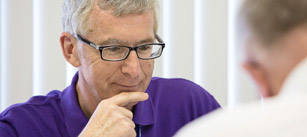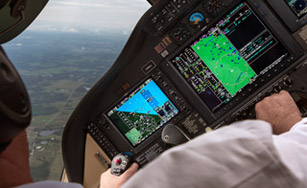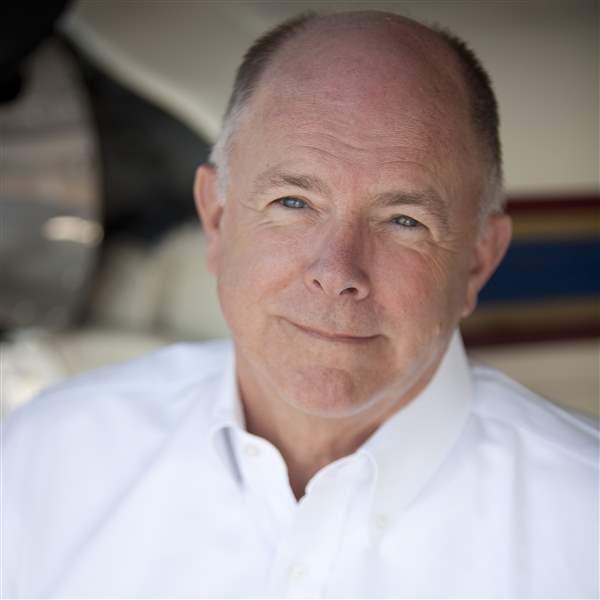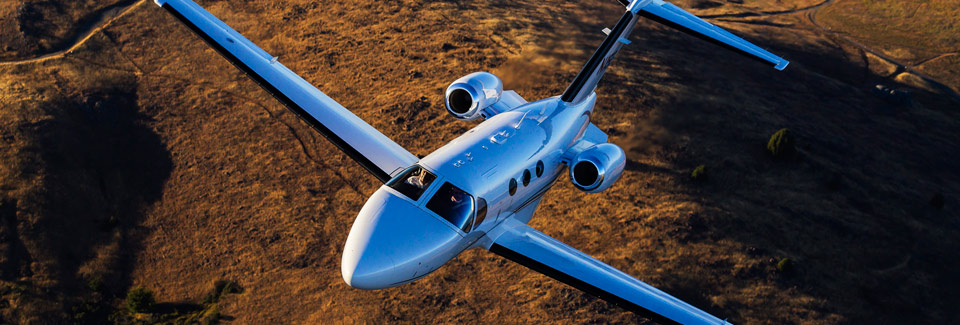
That’s a pretty busy 1.3 hours, and the weather conspired to make many of those approaches take place in actual IMC—some of them to minimums. Another note: Azma likes to teach stalls with the autopilot engaged. The proper response is to recover when the autopilot disengages, using power and pitch to recover airspeed and return to level flight; altitude loss is a secondary concern. The idea is to duplicate real-life accident scenarios in which pilots may have been startled into delayed, improper, or neglected recoveries.
Types of types
There can be more than one type rating for light jets certified for single-pilot operations. Everybody is familiar with the single-pilot type rating (denoted by an “S” suffix to the airplane type on the pilot certificate) that gives single-pilot privileges. But there are two others that are less difficult to earn.
One is the pilot-in-command-crew rating. This rating calls for about five days’ worth of training and a checkride. It also requires that you have a second crewmember. That second crewmember only needs a day or so to learn what’s required, and to qualify as a second crewmember all you need is a private pilot certificate with multiengine and instrument ratings. Second crewmember privileges are valid only within the 48 contiguous United States.
The second-in-command (SIC) type rating is even less stringent. Again, you need a private pilot certificate with multiengine and instrument ratings. An hour’s worth of dual instruction (in the airplane or a simulator) may be all that’s required, in which time you’ll have to fly at least three takeoffs and landings, as well as cope with emergency and abnormal procedures. Ground school emphasizing airplane systems and limitations also is required. You’ll need to have your training logged by an authorized instructor, as well as have an endorsement for the SIC rating. Then it’s a trip to the local FSDO to add the SIC rating to your certificate. Although no checkride is required for the SIC type rating, it’s valid outside the United States.—TAH
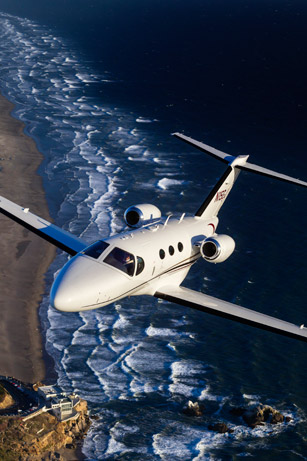
The vast majority of my training in turbine airplanes has been simulator-based, and conducted at facilities run by CAE/Simuflite, FlightSafety International, CAE, and Simcom. The training was excellent, with a daily mix of formal classroom sessions and time spent in the simulators. An old saying goes, “You learn about a certain system in the morning, and that afternoon the same system breaks while you fly the sim.” There’s some truth in that, but there are so many emergencies in the simulator that it’s hard to keep track of what happened when after one to three weeks’ worth of daily flying.
The emphasis on simulator-based training made me curious. Although it seems to have become the industry standard, are there alternatives to earning a type rating that don’t involve simulators and that don’t have such rigid schedules? The answer is yes. Industry publications are full of advertisements placed by smaller—sometimes, one-instructor—training establishments. These programs use the customer’s own airplane as a platform for dual instruction, and dispense with simulators altogether. As for ground school, this is typically done one-on-one in a more personalized approach. What could this training experience be like?
Through a lucky series of events, I found out. I reported for Cessna Citation Mustang type-rating training at Azma FLT Incorporated, located at the Orlando (Florida) International Airport, and settled in for a week’s worth of very intensive training. Azma FLT is run by John Azma, an FAA-designated examiner whose company has been giving flight training and checkrides (10,000 to 15,000 of them, by his count) worldwide for more than 20 years. My instructor was Jack Boyd, one of Azma’s 12 carefully chosen instructors who teach all across the United States. My airplane was N15GJ, a 2008 Mustang.
I’d been given a long list of memory items and a document listing all the Mustang’s limitations beforehand, with the admonition to study these well before arriving at Orlando. Sure enough, the first thing on Boyd’s day-one agenda was for me to recite the memory items. This was as much a test of my powers of recall as it was an entrée for Boyd to begin a daily delving into the Mustang’s systems. After two hours of this, I was thrown into the deep end. Not four hours after arriving, I was in the Mustang’s left seat, doing the preflight checks. A few minutes after that, I was charging down Orlando’s Runway 18R on the first of 10 1.3-hour-long instructional flights.
Each of those flights would include procedures and elements that later would have a strong chance of being tested during Azma’s checkride. “Basically, we’ll be flying the checkride twice a day,” Boyd said. That meant cramming 10 or so tasks into each of the twice-daily flights. Believe me, after five days of this you become very good at quickly configuring the airplane for whatever task—shooting approaches, flying missed approaches, holding, and landing the airplane under a variety of conditions. Much of the time was flown with Boyd having yanked an engine back to flight idle.
But aren’t these the same drills you’d perform in a simulator? Yes, but there are advantages to flying the real thing. For example, you’re actually laying hands on the real airplane, and feeling the true sensations of flight. Approaches and landings also are more real, because, well, they’re real. We also dealt with weather and did plenty of ATC coordination in Orlando’s busy airspace. Many simulators can’t replicate that very well. Simulators also vary in their ability to duplicate the complex aerodynamics and touchdown sensations experienced in ground effect, but when you’re flying the airplane, you’re getting more bang for the buck when it comes to learning how to make better landings. Long story short: you make peace with the airplane in those five days, not a simulator.
Of course, when it comes to truly dire emergency situations: engine fires, split flaps, runaway trim, dual-engine flameouts, smoke in the cockpit, and so on, then the simulator takes the lead. Ditto avionics simulators and flight training devices that introduce neophytes to the Garmin G1000 avionics system—or any step-up avionics system, for that matter. In the best of worlds, training would be a combination of simulator experience and real-world flying. But some customers want their training to fit into their schedules, and can’t spare a week away at a simulator-based school. It’s those customers that Azma caters to.
Here are the procedures flown on most flights:
- V1 cut on takeoff.
- Steep turns. Set power at 70 percent N1 and fly at 200 knots while maintaining a 45-degree bank.
- Stall, clean. Use 40 percent N1 to slow down. Recover at the first sign of a stall.
- Departure stall. TO/Approach flap setting, 50 percent N1, and enter a turn. Recover at the first sign of a stall.
- Landing configuration stall. Full flaps, gear down, and 50 percent N1. Recover at the first sign of a stall.
- Emergency descent. Power idle, speed brakes and landing gear extended, 250 KIAS, 20 degrees nose-down pitch, and a 90-degree turn to a lower altitude.
- Coupled ILS approach to Runway 15 at Kissimmee Gateway Airport (ISM) to a touch-and-go. Single-engine.
- Hand-flown ILS to Kissimmee’s Runway 15, with a low approach and missed approach to the missed-approach holding point, making one turn around the hold. Single-engine.
- Coupled VOR/DME-A approach to Kissimmee, with a circle-to-land to a touch-and-go on Runway 15. Sometimes, we flew the holding pattern at COOPY intersection to reverse course before crossing the final approach fix (COOPY) inbound.
- No-flap landing on the ILS to Orlando’s Runway 18R.
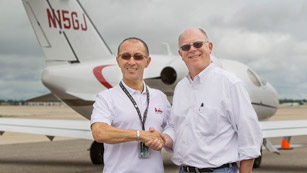 Checkrides are tense experiences for all pilots, but like Boyd, Azma projected a kind of calm that took a lot of the angst out of the cockpit. This left me free to focus on the job at hand, and the checkride turned out to be uneventful. He even passed along some extra information about the Mustang as we went through the preflight inspection and checks.
Checkrides are tense experiences for all pilots, but like Boyd, Azma projected a kind of calm that took a lot of the angst out of the cockpit. This left me free to focus on the job at hand, and the checkride turned out to be uneventful. He even passed along some extra information about the Mustang as we went through the preflight inspection and checks.
This would be just one of the several checkrides that Azma conducted that week. He’s one of only five Mustang examiners in the nation, and he’s also authorized to give checkrides in Cessna Citations (except for the Sovereign and Citation X), the Beechcraft Premier I, all Learjets (except the models 45 and 60), and Dassault’s Falcon 50. His company philosophy emphasizing customized training adapted to individual skill levels and schedules extends to training customers at their home airports, and has led to developing an exclusive clientele.
The nature of one-on-one instruction in owner-flown turbine airplanes may vary, but if Azma’s company is any example, then it’s a strong endorsement as an alternative to simulator-based training. Whatever method you choose, the checkride is just the beginning of your ongoing training—which, if you’re new to turbine flying, should begin with a mentor pilot riding shotgun for as many hours as it takes for you to become comfortable.
Sure, he had his examiner’s hat on for the occasion, and threw a curve or two during the flight—like having me perform an approach to a stall without the autopilot engaged, and actually have me shut an engine down after performing a (simulated) engine-fire drill. And then there were the 400-foot ceilings and busy traffic flows into Orlando. But after 1.5 hours—most of them on instruments—Azma signed me off with a CE-510S (single-pilot privileges) type rating and there were handshakes all around.
Types of types
There can be more than one type rating for light jets certified for single-pilot operations. Everybody is familiar with the single-pilot type rating (denoted by an “S” suffix to the airplane type on the pilot certificate) that gives single-pilot privileges. But there are two others that are less difficult to earn.
One is the pilot-in-command-crew rating. This rating calls for about five days’ worth of training and a checkride. It also requires that you have a second crewmember. That second crewmember only needs a day or so to learn what’s required, and to qualify as a second crewmember all you need is a private pilot certificate with multiengine and instrument ratings. Second crewmember privileges are valid only within the 48 contiguous United States.
The second-in-command (SIC) type rating is even less stringent. Again, you need a private pilot certificate with multiengine and instrument ratings. An hour’s worth of dual instruction (in the airplane or a simulator) may be all that’s required, in which time you’ll have to fly at least three takeoffs and landings, as well as cope with emergency and abnormal procedures. Ground school emphasizing airplane systems and limitations also is required. You’ll need to have your training logged by an authorized instructor, as well as have an endorsement for the SIC rating. Then it’s a trip to the local FSDO to add the SIC rating to your certificate. Although no checkride is required for the SIC type rating, it’s valid outside the United States.—TAH
This would be just one of the several checkrides that Azma conducted that week. He’s one of only five Mustang examiners in the nation, and he’s also authorized to give checkrides in Cessna Citations (except for the Sovereign and Citation X), the Beechcraft Premier I, all Learjets (except the models 45 and 60), and Dassault’s Falcon 50. His company philosophy emphasizing customized training adapted to individual skill levels and schedules extends to training customers at their home airports, and has led to developing an exclusive clientele.
The nature of one-on-one instruction in owner-flown turbine airplanes may vary, but if Azma’s company is any example, then it’s a strong endorsement as an alternative to simulator-based training. Whatever method you choose, the checkride is just the beginning of your ongoing training—which, if you’re new to turbine flying, should begin with a mentor pilot riding shotgun for as many hours as it takes for you to become comfortable.
Sure, he had his examiner’s hat on for the occasion, and threw a curve or two during the flight—like having me perform an approach to a stall without the autopilot engaged, and actually have me shut an engine down after performing a (simulated) engine-fire drill. And then there were the 400-foot ceilings and busy traffic flows into Orlando. But after 1.5 hours—most of them on instruments—Azma signed me off with a CE-510S (single-pilot privileges) type rating and there were handshakes all around.
Logging Mustang time—in style
Renowned guided-tour operator Air Journey now offers a way for qualified pilots to fly the company’s Cessna Mustang on several of its upcoming trips. All that’s needed is for the pilot to earn the pilot-in-command-crew type rating; a qualified Air Journey escort pilot will fly in the right seat to assist the PIC in flying duties. The cost of the Mustang is $1,000 dry per hour, plus fuel, landing fees, parking, and any ATC fees.
The first slots will be available this autumn, when Air Journey conducts its Journey to Africa—a four-segment trip that starts with an Atlantic crossing, then includes stops at Bodrum, Turkey; Capetown, South Africa; and Madeira and Lisbon, Portugal; before returning to the United States. A December trip will go to Latin America, and an around-the-world trip starts in May 2014.
Pilots can fly entire trips, or just one or more legs; build time in the airplane; and polish jet-flying skills—all while taking in the sights and adventures of a liftetime. We’re talking bucket list here. For more information, contact Air Journey at 561-841-1551, or visit the website (www.airjourney.com).—TAH
